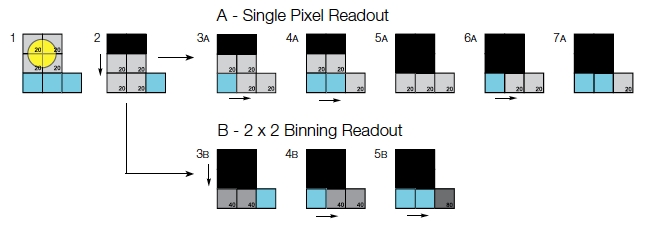Resources
 Part of the Oxford Instruments Group
Part of the Oxford Instruments Group
Expand
Collapse
 Part of the Oxford Instruments Group
Part of the Oxford Instruments Group

A CCD made up of 4 pixel imaging array,in grey, with a readout register below, in blue. The charge held in the pixel is indicated in the bottom right of the pixel.
CCD's are very versatile devices and their readout pattern can be manipulated to achieve various effects. One of the most commonly used is binning. Binning allows charges from adjacent pixels to be combined on the sensor before the charge is readout through the amplifier, the dominant noise source on a CCD. This can offer benefits in faster readout speeds and improved signal to noise ratios with reduced spatial resolution.
To illustrate the difference between the two readout modes we have used a step by step readout diagram.
The diagram is of a CCD made up of 4 pixel imaging array,in grey, with a readout register below, in blue. The charge held in the pixel is indicated in the bottom right of the pixel.
It is important to highlight the main differences in the two readout schemes. In the first we achieve the full spatial resolution of the sensors array. In the binned example we have reduced the 4 pixel pattern to a single pixel 'Superpixel' and hence have lost spatial resolution. However, the binned operation takes fewer steps to readout the sensor and hence is faster. Typically binning 2 x 2 is twice as fast; this is achieved by having to shift the readout register only every two vertical shifts. This relationship holds if we were binning 3 x 3 or 4 x 4 on a CCD with the readout being three and four times faster respectively.
1. The light falls evenly on the four pixels and creates a charge of 20 e- in each of the four pixels.
2. The first operation is to shift the charge down one row. The charge from the lowest pixels gets shifted into the readout register. 3. (A) For single pixel readout, the charge in the readout register is shifted to the right and into the readout amplifier. (B) In the binning operation the charge is shifted down again and the charge from the first row is added, or summed, to the first row in the readout register.
4. (A) For single pixel readout, the first pixel is readout while the readout register is shifted again to shift the charge in the second pixel into the readout amplifier. (B) In the binning operation the summed charge from two right two pixels is shifted into the readout amplifier.
5. (A) In the single pixel readout, the next row is shifted vertically into the readout register. (B) In the binning operation the readout register is shifted again to sum the charge from the five pixels in the readout amplifier before being readout.
6. (A) In the single pixel readout mode, the readout register is shifted to the right again to readout the next pixel. Binned operation is now complete.
7. (A) In the single pixel readout the readout register is shifted to the right again to readout the final pixel.
The binned example also highlights how binning improves the signal to noise ratio. If we assume our CCD has a readout noise of 10 e-, then in the single pixel example each pixel is readout with a noise of 10 e- hence we achieve a signal to noise ratio of 2:1 (20 e-/10 e-). Even if we subsequently sum the four pixels in a computer after readout the signal to noise ratio becomes 4:1. In summing the charge of the four pixels, we sum the signal (4 x 20 ei. e. 80 e-) and the noise is added in quadrature i.e. square root of the sum of the noises squared ( √4 X (10e-)2 i.e. 20e-).
In the binned example there is no noise until the signal is readout by the amplifier, so the signal to noise ratio is 8:1(80 e- / 10 e-) i.e. twice as good as the single pixel readout mode.
One of the most common applications of custom binning in X-ray is in energy-dispersive spectroscopy where low flux conditions with incident higher energies X-ray photons can be directly detected with the larger superpixel gaining the advantage of the lower noise and faster readout to achieve a user definable optimal performance.
